Page,1/1
http://images.amazon.com/images/P/0471392030.01.LZZZZZZZ.jpg
2003-8-12
�
CONTENTS
PREFACE xv
ABOUT THE AUTHOR xxi
| CHAPTER 1 The Nature of Information Technology Projects 1
Global Technology Solutions 1
Introduction 2
How This Book Is Organized 3
The Software Crisis 4
Why IT Projects Fail 4
Improving the Likelihood of Success 6
A Socio-Technical Approach 6
A Project-Management Approach 7
A Knowledge-Management Approach 8 The
Context of Project Management 9
What Is a Project? 9
Attributes of a Project 9 The Project Life
Cycle and IT Development
Define Project Goal 12
Plan Project 13
Execute Project Plan 13
Close Project 14
Evaluate Project 14
The IT Product Life Cycle 14
Planning 15
Analysis 15
Design 15
Implementation 15
Maintenance and Support 15
Putting the SDLC into Practice 16
12
�
vi INFORMATION TECHNOLOGY PROJECT MANAGEMENT
Structured Approach to Systems Development 16 Rapid Applications
Development (RAD) 16 The PLC versus the SDLC 18 The Project
Management Body of Knowledge (PMBOK) 19
Project Management Knowledge Areas 19
Chapter Summary 21 Review Questions 21 Extend
Tour Knowledge 22 Bibliography 22
CHAPTER 2 Conceptualizing and Initializing the IT Project 23
Global Technology Solutions 23
Introduction 25
An Information Technology Project Methodology (ITPM) 25
Phase 1: Conceptualize and Initialize 27
Phase 2: Develop the Project Charter and
Detailed Project Plan 28
Phase 3: Execute and Control the Project 29
Phase 4: Close Project 29
Phase 5: Evaluate Project Success 30
IT Project Management Foundation 30
Project Management Processes 31
Project Objectives 31
Tools 31
Infrastructure 31
Project Management Knowledge Areas 32 The
Business Case 32
What Is a Business Case? 32
Developing the Business Case 33
Step 1: Select the Core Team 33
Step 2. Define Measurable Organizational Value (MOV) 34
Step 3: Identify Alternatives 40
Step 4: Define Feasibility and Assess Risk 41
Step 5: Define Total Cost of Ownership 42
Step 6: Define Total Benefits of Ownership 42
Step 7: Analyze Alternatives 43
Step 8: Propose and Support the Recommendation 47
Project Selection and Approval 48
The IT Project Selection Process 49
The Project Selection Decision 49
�
CONTENTS Vii
Chapter Summary 52 Review
Questions 53 Extend Tour
Knowledge 54 Bibliography
54
| CHAPTER 3 Developing the Project Charter and Baseline Project Plan 55
Global Technology Solutions 55
Introduction 56
Project Management Processes 57
58
Project Management Process Groups
Initiating 58
Planning 59
Executing 60
Controlling 60
Closing 60 Project Integration
Management 60
Project Plan Development 61
Project Plan Execution 62
Overall Change Control 62
The Project Charter 63
65
65
What Should Be in a Project Charter?
Project Identification 65
Project Stakeholders 65
Project Description 65
Measurable Organizational Value (MOV)
Project Scope 65
Project Schedule 66
Project Budget 66
Quality Issues 66
Resources 66
Assumptions and Risks
Project Administration
Acceptance and Approval
References 67
Terminology 67 Project
66
67
67
Planning Framework
68
The MOV 69
Define the Project's Scope
Subdivide the Project into Phases 70
Tasks—Sequence, Resources, and Time Estimates
69
70
�
Viii INFORMATION TECHNOLOGY PROJECT MANAGEMENT
Sequence 70
Resources 70
Time 71
Schedule and Budget—The Baseline Plan 71
The Kick-Off Meeting 71 Chapter Summary 72
Review Questions 72 Extend Tour Knowledge 73
CHAPTER 4 The Human Side of Project Management 74
Global Technology Solutions 74
Introduction 75
Organization and Project Planning 76
The Formal Organization 77
The Functional Organization 77
The Project Organization 81
The Matrix Organization 82
Which Organizational Structure Is Best"? 84
The Informal Organization 85
Stakeholders 85
Stakeholder Analysis 85
The Project Team 86
The Roles of the Project Manager 86
Team Selection and Acquisition 88
Team Performance 88
Work Groups 89
Real Teams 89
Project Teams and Knowledge Management 91
Learning Cycles and Lessons Learned 92 The
Project Environment 96 Chapter Summary 97
Review Questions 98 Extend Tour Knowledge 99
Bibliography 100
CHAPTER 5 Defining and Managing Project Scope
101
Global Technology Solutions 101
Introduction 102
Project Scope Management Processes 102
�
CONTENTS iX
Project Scope Initiation 104
Project Scope Planning 105
Scope Boundary 105 The Scope
Statement 105 Scope Statement
105 Out of Scope for this Project 106
Project Scope Definition 107
Project-Oriented Scope 107
Project-Oriented Scope Definition Tools 107
Product-Oriented Scope 109
Product-Oriented Scope Definition Tools 109
Project Scope Verification 111
Scope Change Control 113
Scope Change Control Procedures 114
Benefits of Scope Control 117
Chapter Summary 117
Review Questions 117
Extend Tour Knowledge 119
Bibliography 119
CHAPTER 6 The Work Breakdown Structure and Project Estimation 120
Global Technology Solutions 120
Introduction 122
The Work Breakdown Structure (WBS) 123
Work Packages 123
Deliverables and Milestones 124
Developing the WBS 125
The WBS Should Be Deliverable-Oriented 126
The WBS Should Support the Project's MOV 126
The Level of Detail Should Support Planning and Control 127
Developing the WBS Should Involve the People Who Will Be Doing the Work 128
Learning Cycles and Lessons Learned Can Support the
Development of a WBS 128
Project Estimation 128
Guesstimating 128 Delphi
Technique 129 Time Boxing
129 Top-Down Estimating
129 Bottom-Up Estimating
130
�
X INFORMATION TECHNOLOGY PROJECT MANAGEMENT
Software Engineering Metrics and Approaches 131
Lines of Code (LOG) 133
Function Points 133
COCOMO 137
Heuristics 139
Automated Estimating Tools 140 What Is the Best
Way to Estimate IT Projects? 140 Chapter Summary
141 Web Sites to Visit 142 Review Questions 142 Extend
Tour Knowledge 143 Bibliography 144
CHAPTER 7 The Project Schedule and Budget 146
Global Technology Solutions 146
Introduction 148
Developing the Project Schedule 149
Gantt Charts 150
Project Network Diagrams 150
Activity on the Node (AON) 151
Critical Path Analysis 152
PERT 153
Precedence Diagramming Method (PDM) 154
Project Management Software Tools 156
Developing the Project Budget 158
Cost Estimation 159
Other Costs 161
Resource Allocation 163
Finalizing the Project Schedule and Budget 163
Chapter Summary 164 Review Questions 165 Extend Tour
Knowledge 165 Bibliography 165
CHAPTER 8 Managing Project Risk 166
166
Global Technology Solutions
Introduction 168
IT Project Risk Management Planning Process
170
Risk Planning 171
�
CONTENTS Xi
Risk Identification 171
Risk Assessment 172
Risk Strategies 172
Risk Monitoring and Control 173
Risk Response 173
Risk Evaluation 173 Identifying IT
Project Risks 173
An IT Project Risk Management Framework 174
Applying the IT Project Risk Management Framework 175
Tools and Techniques 177 Risk
Analysis and Assessment 179
Qualitative Approaches 179
Expected Value 180
Decision Trees 180
Risk Impact Table 181
Quantitative Approaches 183
Discrete Probability Distributions 183
Continuous Probability Distributions 184
Simulations 187 Risk Strategies 190
Risk Monitoring and Control 192 Risk
Response and Evaluation 193 Chapter
Summary 194 Web Sites to Visit 195 Review
Questions 195 Extend Tour Knowledge 196
Bibliography 196
| CHAPTER 9 Project Communication, Tracking, and Reporting
197
Global Technology Solutions 197
Introduction 199
Monitoring and Controlling the Project 200
The Project Communications Plan 202
Project Metrics 203 Earned Value 205
Reporting Performance and Progress 209
Information Distribution 210 Chapter Summary
213 Review Questions 215
�

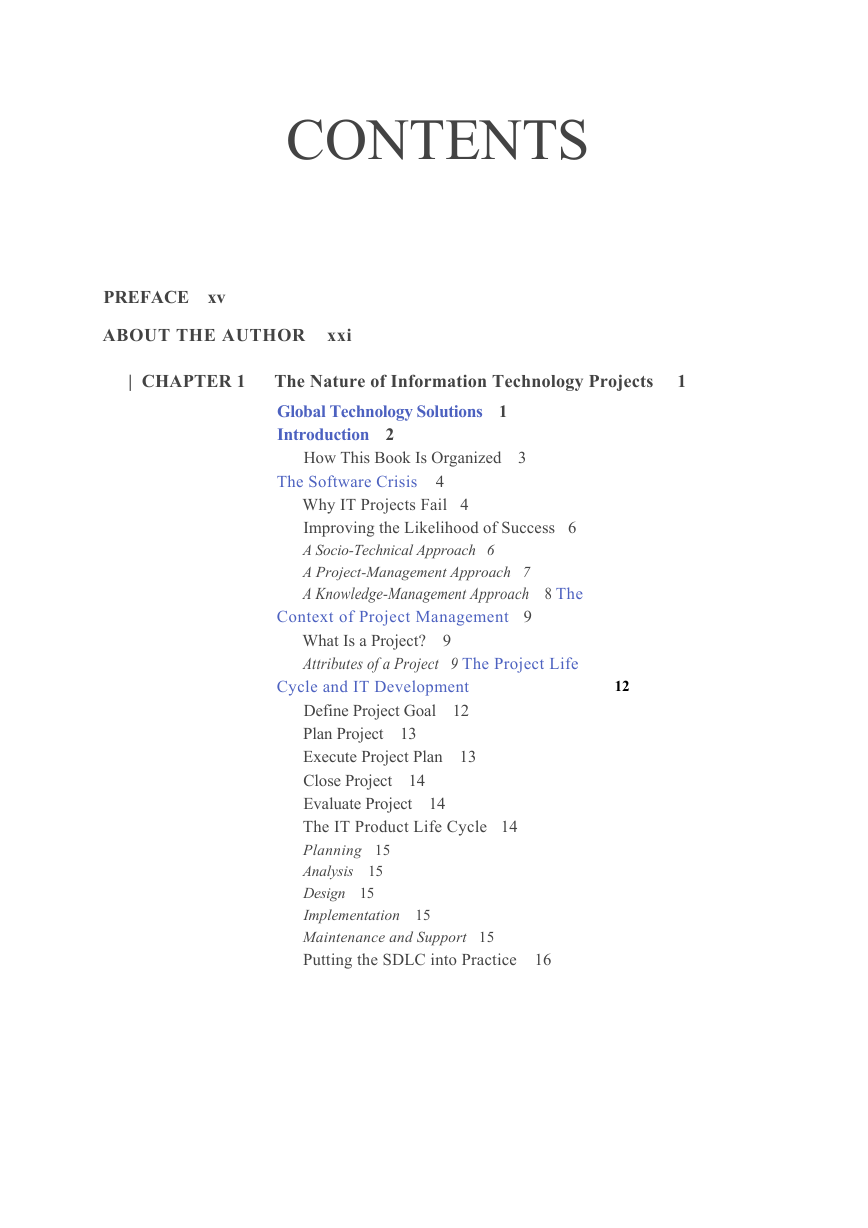
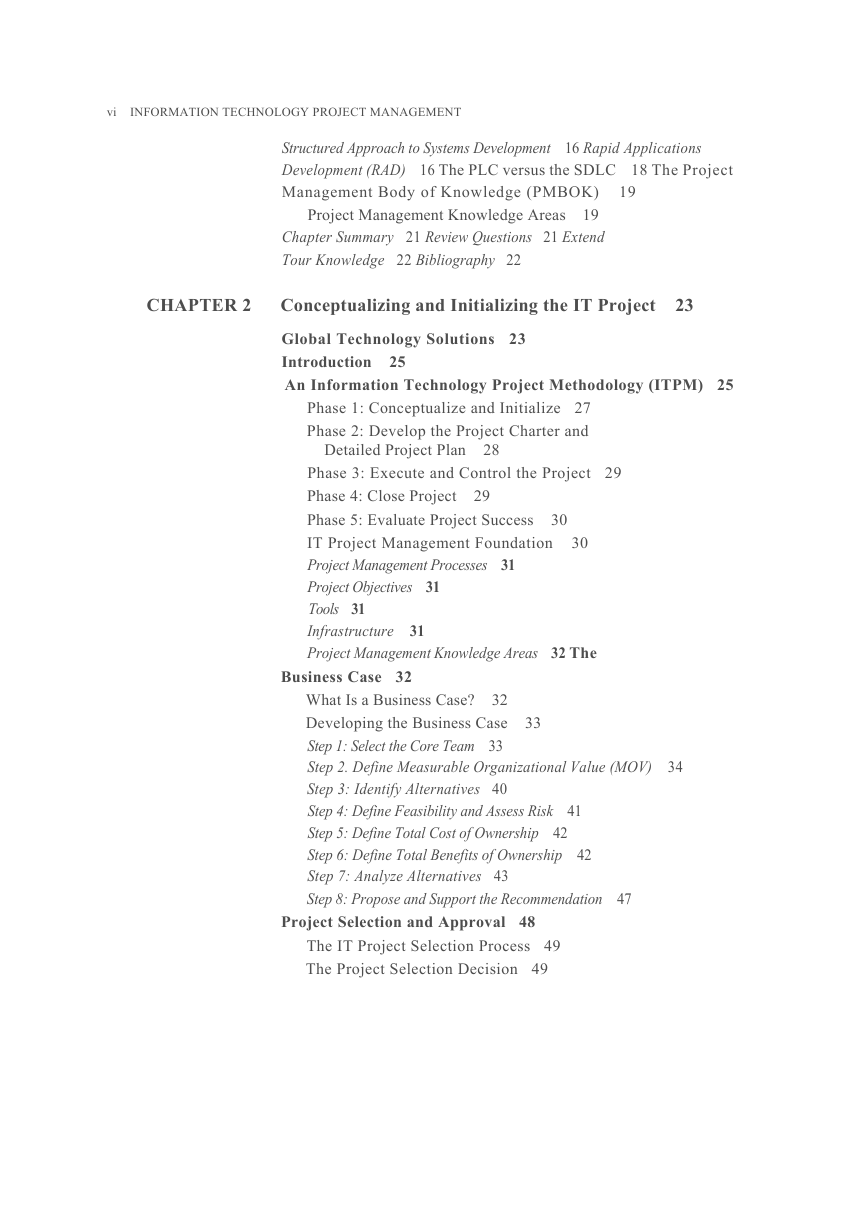
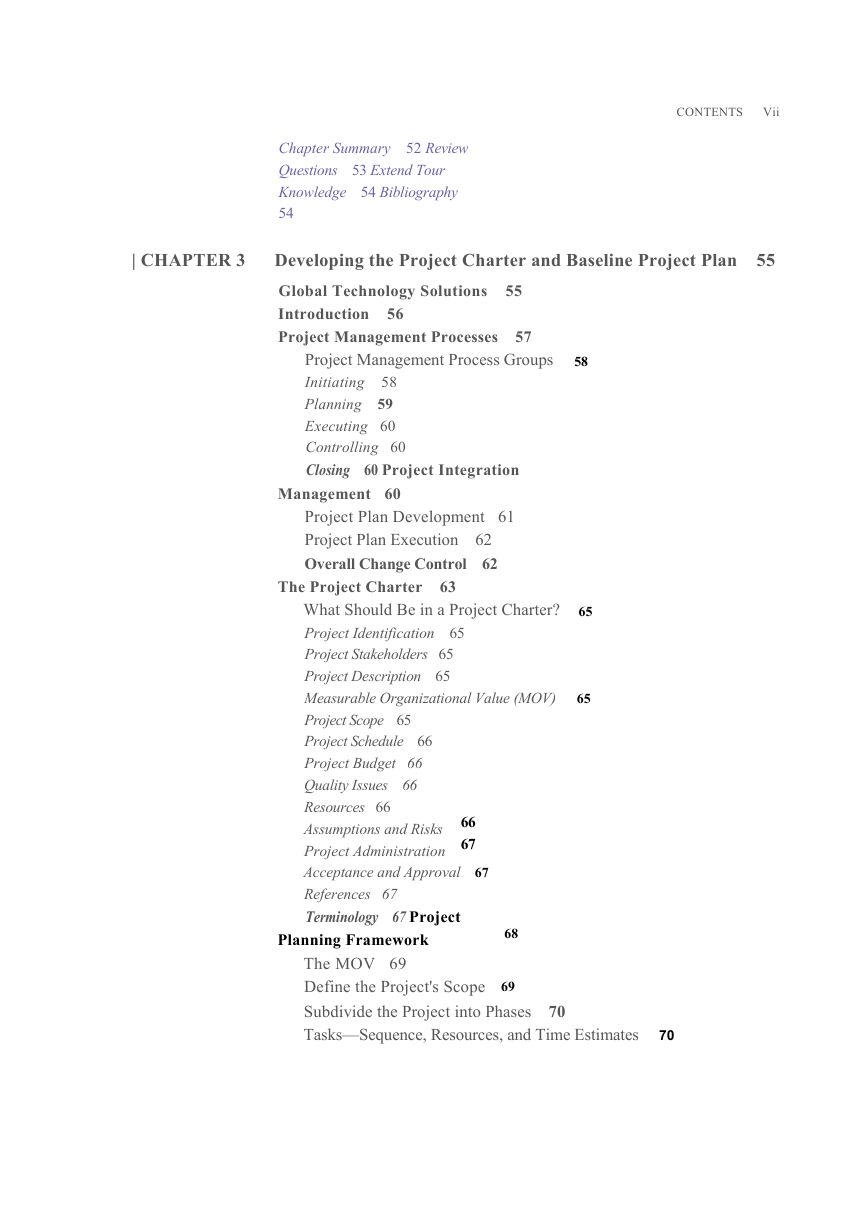
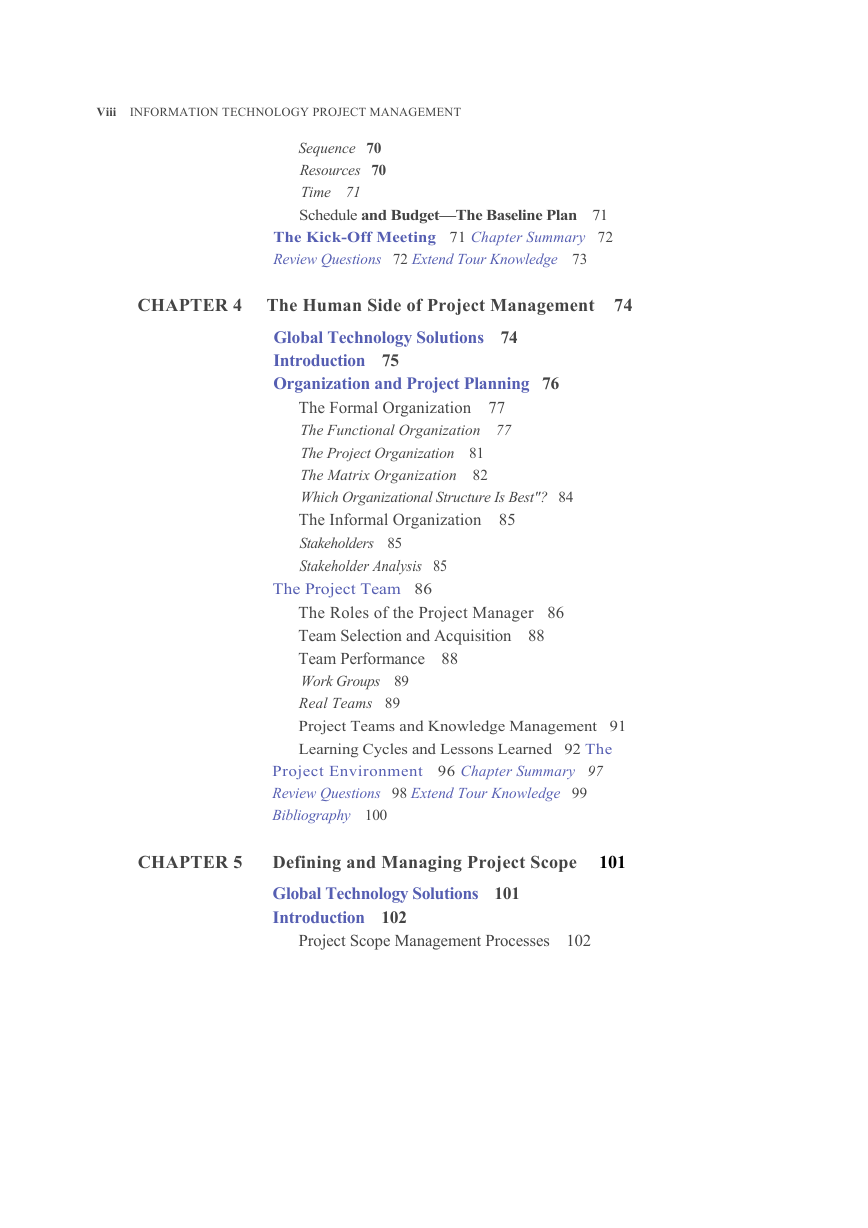
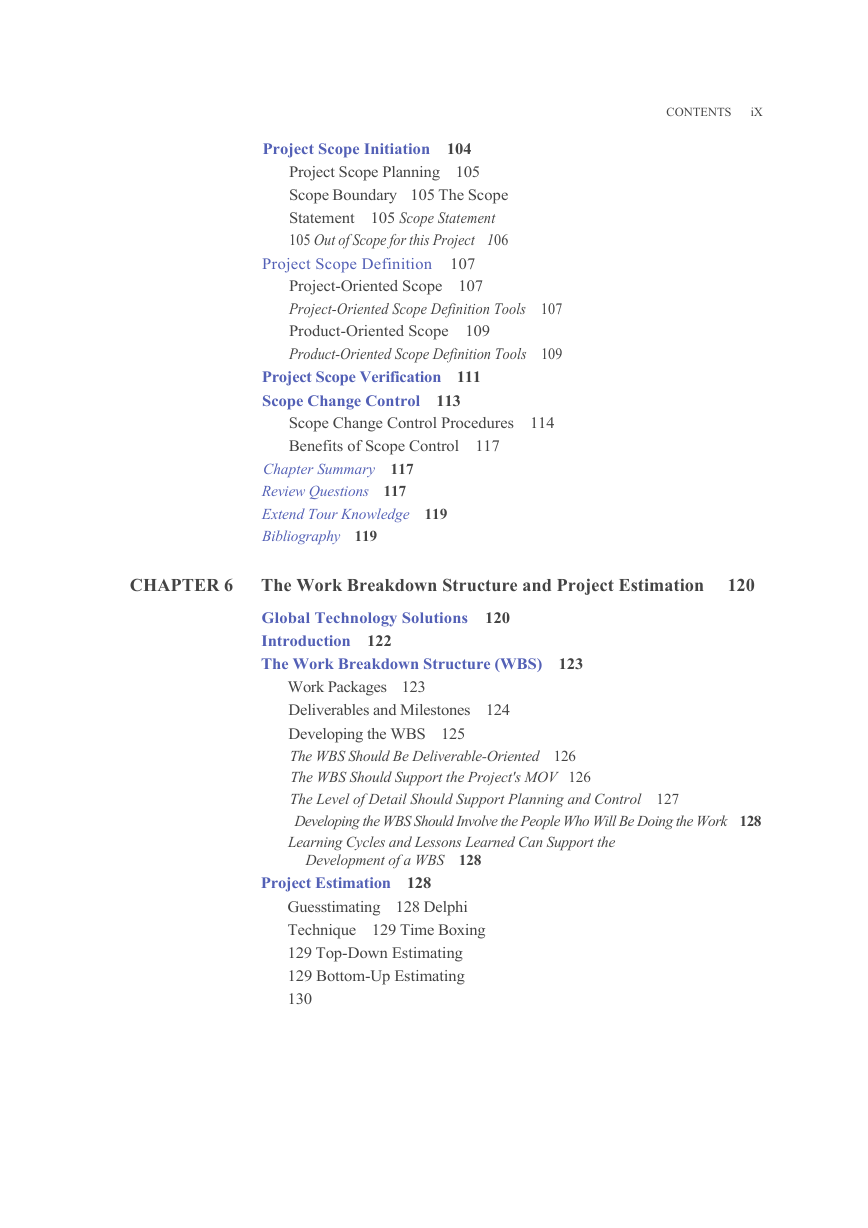
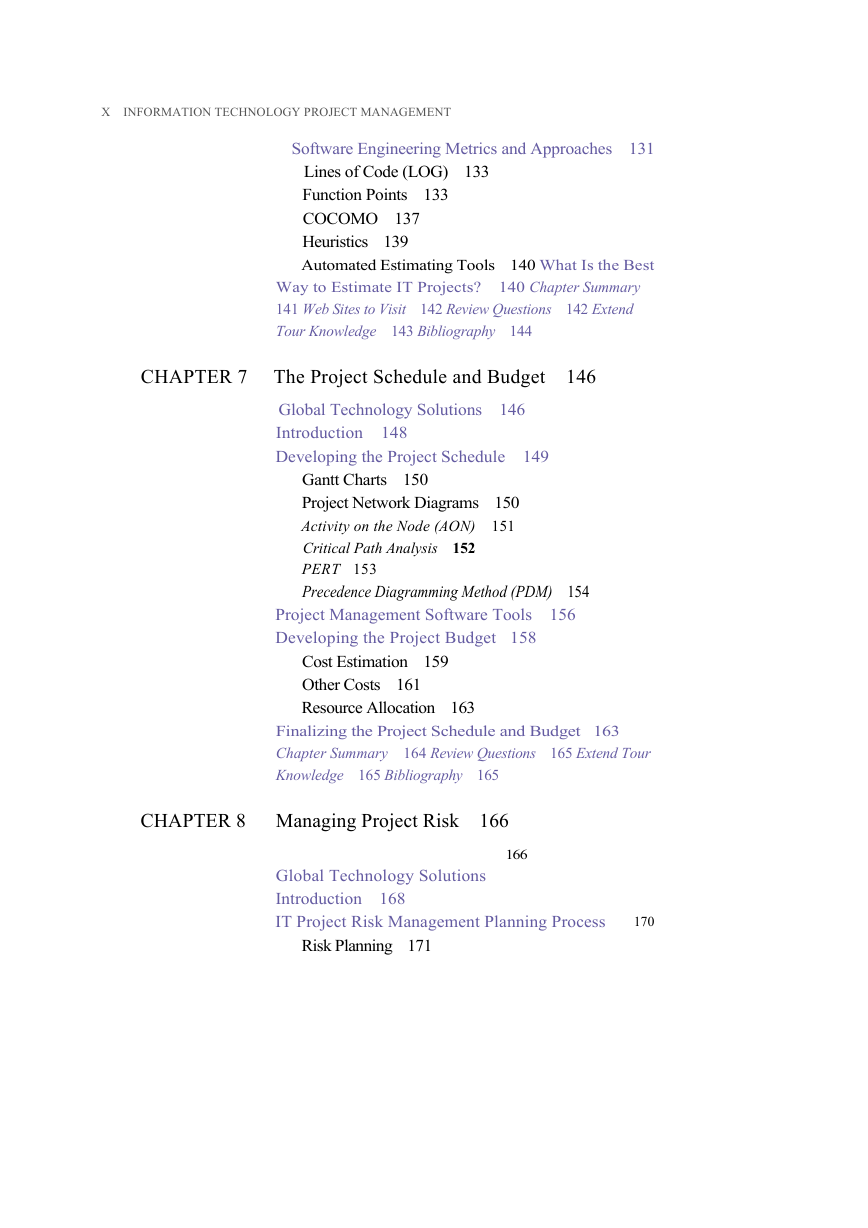









 2023年江西萍乡中考道德与法治真题及答案.doc
2023年江西萍乡中考道德与法治真题及答案.doc 2012年重庆南川中考生物真题及答案.doc
2012年重庆南川中考生物真题及答案.doc 2013年江西师范大学地理学综合及文艺理论基础考研真题.doc
2013年江西师范大学地理学综合及文艺理论基础考研真题.doc 2020年四川甘孜小升初语文真题及答案I卷.doc
2020年四川甘孜小升初语文真题及答案I卷.doc 2020年注册岩土工程师专业基础考试真题及答案.doc
2020年注册岩土工程师专业基础考试真题及答案.doc 2023-2024学年福建省厦门市九年级上学期数学月考试题及答案.doc
2023-2024学年福建省厦门市九年级上学期数学月考试题及答案.doc 2021-2022学年辽宁省沈阳市大东区九年级上学期语文期末试题及答案.doc
2021-2022学年辽宁省沈阳市大东区九年级上学期语文期末试题及答案.doc 2022-2023学年北京东城区初三第一学期物理期末试卷及答案.doc
2022-2023学年北京东城区初三第一学期物理期末试卷及答案.doc 2018上半年江西教师资格初中地理学科知识与教学能力真题及答案.doc
2018上半年江西教师资格初中地理学科知识与教学能力真题及答案.doc 2012年河北国家公务员申论考试真题及答案-省级.doc
2012年河北国家公务员申论考试真题及答案-省级.doc 2020-2021学年江苏省扬州市江都区邵樊片九年级上学期数学第一次质量检测试题及答案.doc
2020-2021学年江苏省扬州市江都区邵樊片九年级上学期数学第一次质量检测试题及答案.doc 2022下半年黑龙江教师资格证中学综合素质真题及答案.doc
2022下半年黑龙江教师资格证中学综合素质真题及答案.doc